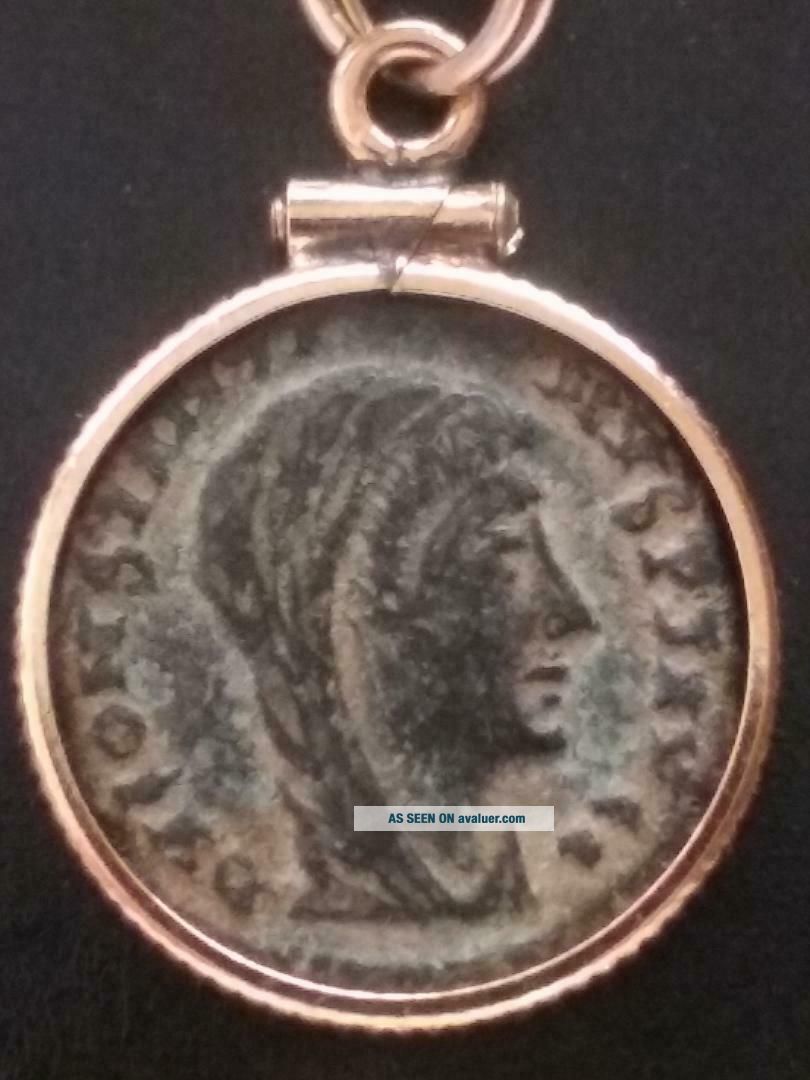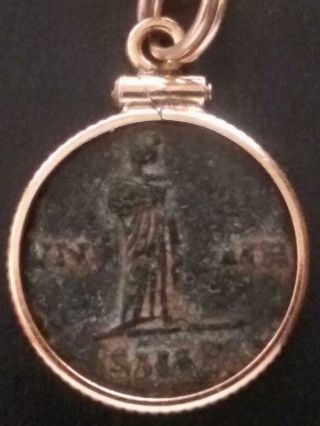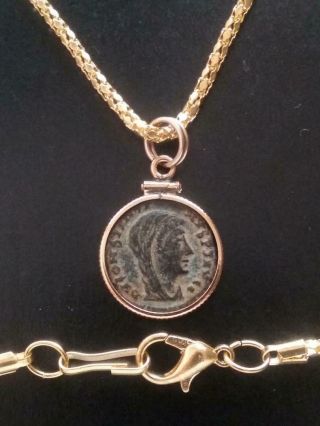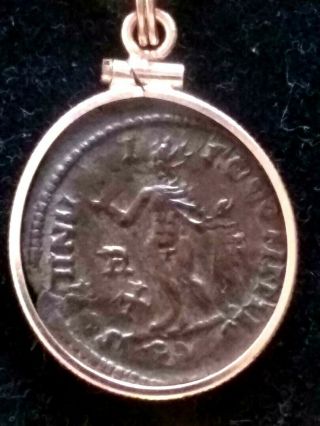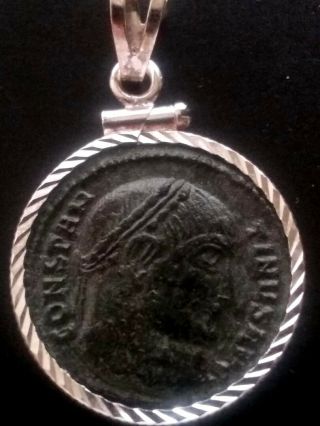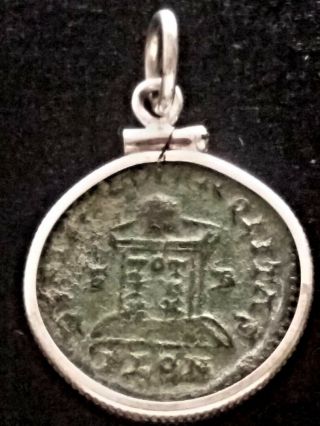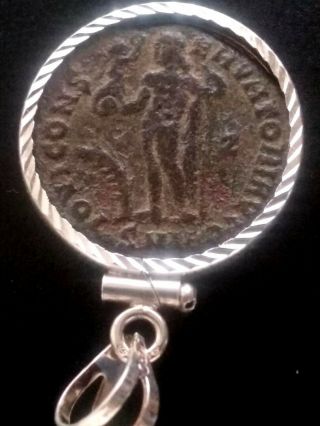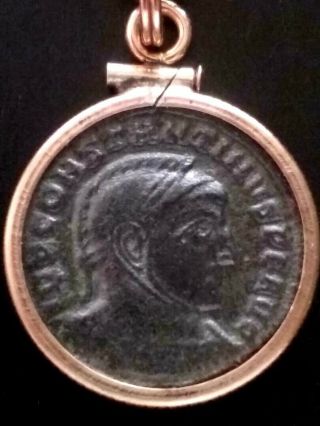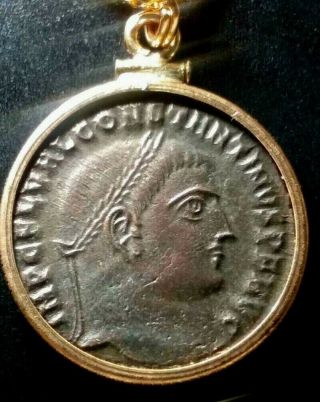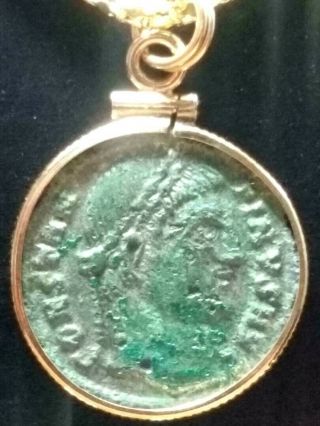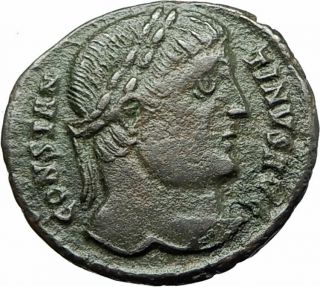Constantine Great Posthumous Authentic Ancient Roman Coin Gold - Filled Necklace
Item History & Price
| Reference Number: Avaluer:9929739 | Modified Item: No |
LOT # 1051=========High quality genuine ancient Roman imperial coin of Constantine the great.Veiled reverse. Great detail and definition.
Please refer to the pictures. This is the actual coin Pendant you'll receive.
We took utmost care to preserve it's patina during cleaning as they are part of the history.To complement this coin we used a bright sterling silver setting to contrast the darker surface sandy desert patina of the coin.
Coin is 15mm diameter and pendant ...is 17mm 12K gold-filled bezel.Excellent portrait and legend. Well centered.20" gold-tone snake chain included.Beautiful natural grey patina has been painstakingly preserved during cleaning process.
Constantine I AE Follis. 347-8 AD. Alexandria RIC VIII 32DV CONSTANTINVS PT AVGG, veiled bust right VN-MR, Emperor veiled standing right.Mintmark SMAL and officina letter.
Will ship in bubble padded envelope with tracking number provided.
Please See other items for high grade Roman coin pendants and earrings and other cool stuff.
Constantine the Great (Latin: Flavius Valerius Aurelius Constantinus Augustus; Greek: Κωνσταντῖνος ὁ Μέγας; 27 February c. 272 AD – 22 May 337 AD), also known as Constantine I or Saint Constantine (in the Orthodox Church as Saint Constantine the Great, Equal-to-the-Apostles), was a Roman Emperor of Illyrian-Greek origin from 306 to 337 AD. He was the son of Flavius Valerius Constantius, a Roman Army officer, and his consort Helena. His father became Caesar, the deputy emperor in the west, in 293 AD. Constantine was sent east, where he rose through the ranks to become a military tribune under Emperors Diocletian and Galerius. In 305, Constantius raised himself to the rank of Augustus, senior western emperor, and Constantine was recalled west to campaign under his father in Britannia (Britain). Constantine was acclaimed as emperor by the army at Eboracum (modern-day York) after his father's death in 306 AD, and he emerged victorious in a series of civil wars against Emperors Maxentius and Licinius to become sole ruler of both west and east by 324 AD.
As emperor, Constantine enacted many administrative, financial, social, and military reforms to strengthen the empire. The government was restructured, and the civil and military authorities were separated. A new gold coin was introduced to combat inflation known as the solidus. It became the standard for Byzantine and European currencies for more than a thousand years. In military matters, the Roman army was reorganised to consist of mobile field units and garrison soldiers capable of countering internal threats and barbarian invasions. Constantine pursued successful campaigns against the tribes on the Roman frontiers—the Franks, the Alamanni, the Goths, and the Sarmatians—even resettling territories abandoned by his predecessors during the Crisis of the Third Century.
Constantine was the first Roman emperor to convert to Christianity, and he played an influential role in the proclamation of the Edict of Milan in 313, which declared religious tolerance for Christianity in the Roman empire. He called the First Council of Nicaea in 325, at which the Nicene Creed was adopted by Christians. The Church of the Holy Sepulchre was built on his orders at the purported site of Jesus' tomb in Jerusalem and became the holiest place in Christendom. The Papal claim to temporal power in the High Middle Ages was based on the supposed Donation of Constantine. He is venerated as a saint by Eastern Orthodox and Byzantine Catholics. He has historically been referred to as the "First Christian Emperor", and he did heavily promote the Christian Church. Some modern scholars, however, debate his beliefs and even his comprehension of the Christian faith itself.
The age of Constantine marked a distinct epoch in the history of the Roman Empire. He built a new imperial residence at Byzantium and renamed the city Constantinople after himself (the laudatory epithet of "New Rome" came later, and was never an official title). It became the capital of the Empire for more than a thousand years, with the later eastern Roman Empire now being referred to as the Byzantine Empire. His more immediate political legacy was that he replaced Diocletian's tetrarchy with the principle of dynastic succession by leaving the empire to his sons. His reputation flourished during the lifetime of his children and centuries after his reign. The medieval church upheld him as a paragon of virtue, while secular rulers invoked him as a prototype, a point of reference, and the symbol of imperial legitimacy and identity. Beginning with the Renaissance, there were more critical appraisals of his reign due to the rediscovery of anti-Constantinian sources. Trends in modern and recent scholarship have attempted to balance the extremes of previous scholarship.
Please refer to the pictures. This is the actual coin Pendant you'll receive.
We took utmost care to preserve it's patina during cleaning as they are part of the history.To complement this coin we used a bright sterling silver setting to contrast the darker surface sandy desert patina of the coin.
Coin is 15mm diameter and pendant ...is 17mm 12K gold-filled bezel.Excellent portrait and legend. Well centered.20" gold-tone snake chain included.Beautiful natural grey patina has been painstakingly preserved during cleaning process.
Constantine I AE Follis. 347-8 AD. Alexandria RIC VIII 32DV CONSTANTINVS PT AVGG, veiled bust right VN-MR, Emperor veiled standing right.Mintmark SMAL and officina letter.
Will ship in bubble padded envelope with tracking number provided.
Please See other items for high grade Roman coin pendants and earrings and other cool stuff.
Constantine the Great (Latin: Flavius Valerius Aurelius Constantinus Augustus; Greek: Κωνσταντῖνος ὁ Μέγας; 27 February c. 272 AD – 22 May 337 AD), also known as Constantine I or Saint Constantine (in the Orthodox Church as Saint Constantine the Great, Equal-to-the-Apostles), was a Roman Emperor of Illyrian-Greek origin from 306 to 337 AD. He was the son of Flavius Valerius Constantius, a Roman Army officer, and his consort Helena. His father became Caesar, the deputy emperor in the west, in 293 AD. Constantine was sent east, where he rose through the ranks to become a military tribune under Emperors Diocletian and Galerius. In 305, Constantius raised himself to the rank of Augustus, senior western emperor, and Constantine was recalled west to campaign under his father in Britannia (Britain). Constantine was acclaimed as emperor by the army at Eboracum (modern-day York) after his father's death in 306 AD, and he emerged victorious in a series of civil wars against Emperors Maxentius and Licinius to become sole ruler of both west and east by 324 AD.
As emperor, Constantine enacted many administrative, financial, social, and military reforms to strengthen the empire. The government was restructured, and the civil and military authorities were separated. A new gold coin was introduced to combat inflation known as the solidus. It became the standard for Byzantine and European currencies for more than a thousand years. In military matters, the Roman army was reorganised to consist of mobile field units and garrison soldiers capable of countering internal threats and barbarian invasions. Constantine pursued successful campaigns against the tribes on the Roman frontiers—the Franks, the Alamanni, the Goths, and the Sarmatians—even resettling territories abandoned by his predecessors during the Crisis of the Third Century.
Constantine was the first Roman emperor to convert to Christianity, and he played an influential role in the proclamation of the Edict of Milan in 313, which declared religious tolerance for Christianity in the Roman empire. He called the First Council of Nicaea in 325, at which the Nicene Creed was adopted by Christians. The Church of the Holy Sepulchre was built on his orders at the purported site of Jesus' tomb in Jerusalem and became the holiest place in Christendom. The Papal claim to temporal power in the High Middle Ages was based on the supposed Donation of Constantine. He is venerated as a saint by Eastern Orthodox and Byzantine Catholics. He has historically been referred to as the "First Christian Emperor", and he did heavily promote the Christian Church. Some modern scholars, however, debate his beliefs and even his comprehension of the Christian faith itself.
The age of Constantine marked a distinct epoch in the history of the Roman Empire. He built a new imperial residence at Byzantium and renamed the city Constantinople after himself (the laudatory epithet of "New Rome" came later, and was never an official title). It became the capital of the Empire for more than a thousand years, with the later eastern Roman Empire now being referred to as the Byzantine Empire. His more immediate political legacy was that he replaced Diocletian's tetrarchy with the principle of dynastic succession by leaving the empire to his sons. His reputation flourished during the lifetime of his children and centuries after his reign. The medieval church upheld him as a paragon of virtue, while secular rulers invoked him as a prototype, a point of reference, and the symbol of imperial legitimacy and identity. Beginning with the Renaissance, there were more critical appraisals of his reign due to the rediscovery of anti-Constantinian sources. Trends in modern and recent scholarship have attempted to balance the extremes of previous scholarship.



